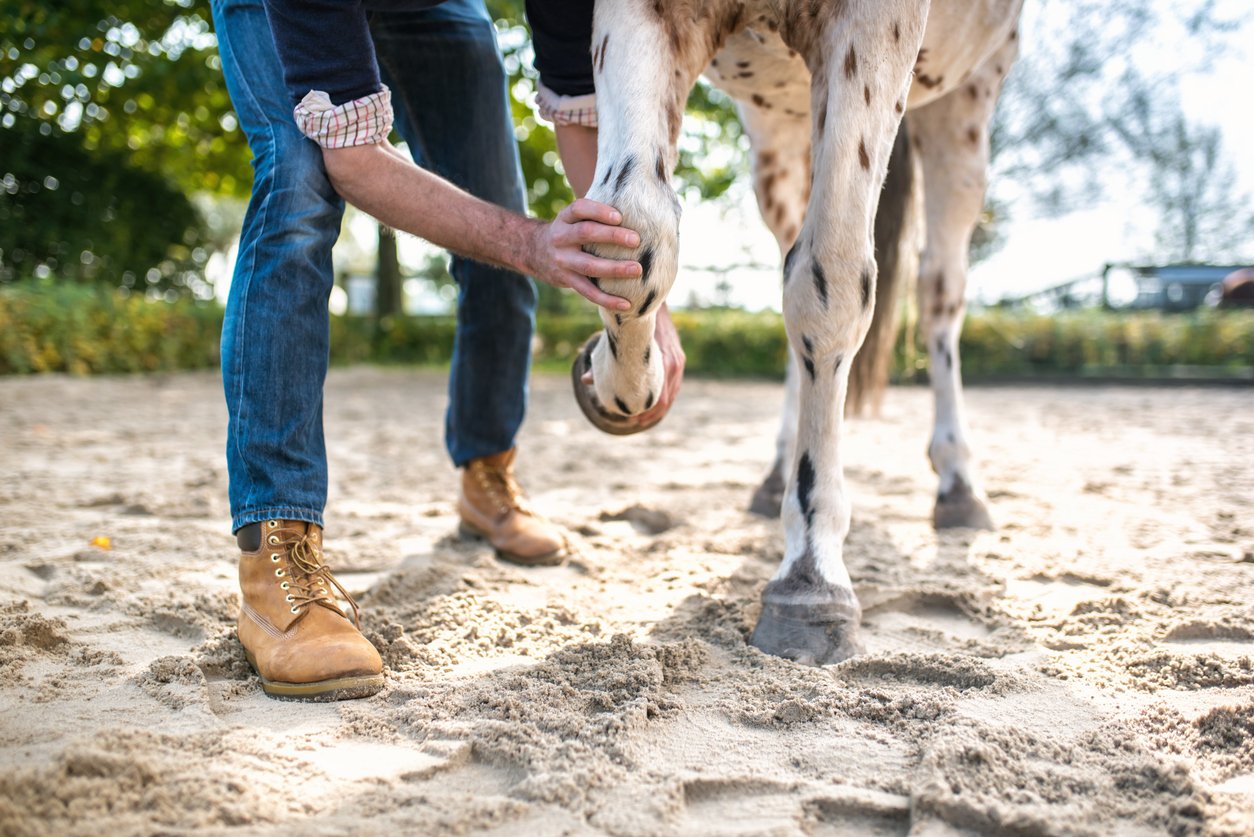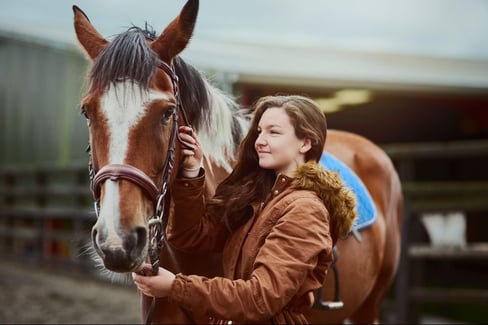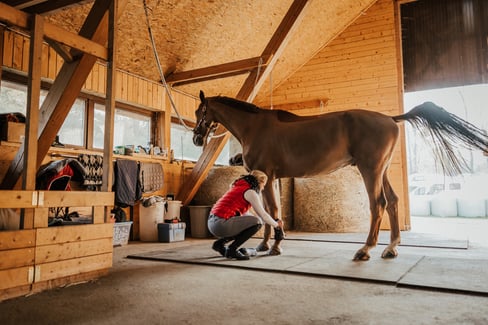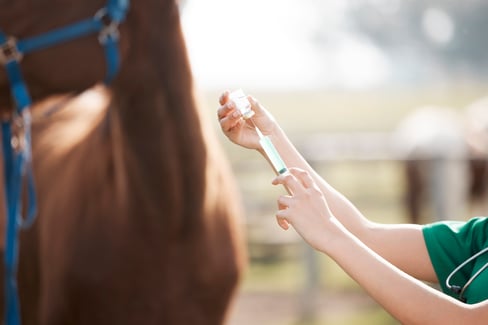Table of Contents
Imagine you’ve spent months training your racehorse to get him ready for the next big competition. As he’s speeding down the track at over 30km/h and you both feel the wind in your hair, you feel him hesitate. No matter, you’re almost at the finish line. As soon as he crosses that white line, you hear him whinny, and after he slows down and stops, he immediately lifts his right front leg. You suspect he might have a horse fetlock joint injury upon examining the affected limb.
Unfortunately, injury to the horse fetlock joint causing lameness is a common injury for race and performance horses. The extent of the injury, including whether it involves only the joint itself or the soft tissue surrounding the joint, depends on the horse's activities.
Thankfully, careful physical examination makes many fetlock joint horse problems fairly easy to diagnose.
What Is a Fetlock Joint on a Horse?
The horse fetlock joint is the name of the structure between a horse’s cannon bone (a long bone that extends from the knee of the horse to the ankle) and pastern bone (the area between the hoof and the fetlock joint) making up the “ankle” of the horse.
Looking at the image below, the horse fetlock joint is the little “bump” at the top and back of the horse’s “ankle” and is responsible for the movement of the hoof.
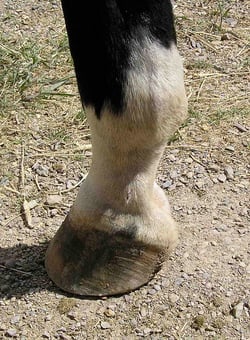
A fun fact about horse ankles is that they contain no muscles and are more similar to human fingers than our own ankles and feet!
When your horse moves, the fetlock joint undergoes high motion, exposing it to extensive force. Typically, the soft tissue structures surrounding the fetlock joint support the joint as it moves. But when injury to these soft tissue structures occurs, or injury to the joint itself, it significantly impacts the horse’s ability to move properly and can be quite painful for your horse. Because of the high level of athleticism required for horse races and performance sports, injury to the equine fetlock joint is common when a horse engages in these activities.
Anatomy of Horse Ankle Bone
To better understand how the fetlock joint fits within the many structures of a horse ankle bone, let’s take a look at a simplified diagram that showcases the basic anatomy of the horse ankle bone:
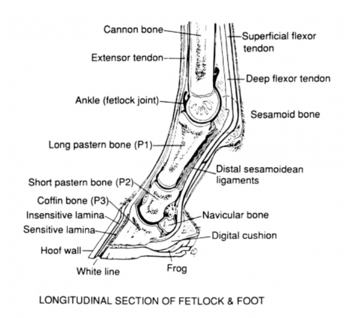
- Cannon bone—Extends from the knee (or hock) to the fetlock joint.
- Superficial flexor tendon—Runs along the back of the cannon bone and connects the short pastern to the coffin bone. The superficial flexor tendon stabilizes and supports the fetlock joint.
- Extensor tendon—Runs down the front of the pastern and cannon bones. This tendon straightens the horse’s leg after he lifts it up.
- Deep flexor tendon—Extends from behind the knee (or hock) down the back of the cannon bone, behind the fetlock and pastern joints, and attaches to the underside of the pedal bone in the hoof capsule.
- Horse fetlock joint is where the cannon bone, proximal sesamoid bones, and the long pastern bone meet.
- Sesamoid bone—Anchors the horse’s foot and fetlock joint together, allowing them to move properly.
- Long pastern bone—Located between the fetlock and short pastern bone. It’s about one-third the length of the cannon bone and functions to increase the flexibility of the fetlock joint.
- Distal sesamoidean ligaments—Short, thick ligaments on the back of the long pastern bone that attach the sesamoid bones on the back of the fetlock joint to the pastern bones.
- Short pastern bone—One of the bones that make up the coffin joint in the horse's hoof.
- Coffin bone—The hoof-shaped bone that connects the laminae in the horse’s hoof.
- Navicular bone—A small flattened bone that lies across the back of the coffin bone. It is connected the pedal bone to the short pastern bone via ligaments.
- Insensitive lamina—Located on the inside of the hoof wall and is semi-rigid in structure. It has no blood supply.
- Sensitive lamina—Filled with nerves and blood vessels that fill the entire area between the hoof wall and the coffin bone. The sensitive lamina and insensitive lamina interlock together like Velcro.
- Digital cushion—Protects the foot’s bone and soft-tissue structures.
- Hoof wall—The part of the hoof that is visible. It covers the front and sides of the coffin bone.
- White line—Located just inside the hoof wall, the white line has a chalky texture and connects the hoof wall to the sole of the horse’s foot.
- Frog—A tough, thick, v-shaped structure that points toward the front of your horse’s hoof. It protects the digital cushion and aids in traction and circulation in the hoof. It also acts as a shock absorber when the horse moves.
Basic Horse Leg Anatomy
The front and back limbs of a horse contain the same structures. The only difference is that the front limb has a “knee” (carpus), and the back limb has a hock (tarsus).
- The “knee” of a horse actually functions more like a human elbow, acting like a hinge that allows the leg to extend. It’s better to think of the carpus of the horse as a human elbow that’s connected to a shoulder and wrist rather than how a knee is connected to a leg.
- The hock functions like a human ankle, allowing the horse to carry weight, push off the ground, and run, jump, and turn.
But wait, didn’t we just say that the fetlock is the horse ankle bone?
The truth is that the horse fetlock joint isn’t really the horse’s ankle bone at all!
- On a horse’s front leg, the fetlock joint is more like the middle knuckle joint on a human hand.
- On a horse’s back leg, the fetlock joint is more like the middle metatarsophalangeal joint (the long bones in the middle of your foot that connect your toes to your ankle).
It’s important to understand how a horse’s limbs work compared to ours so that the horse can be stretched and exercised correctly. If you think of the horse’s wrists like human knees, you may not stretch this area of your horse correctly before a workout.
Common Causes of Horse Fetlock Joint Injury
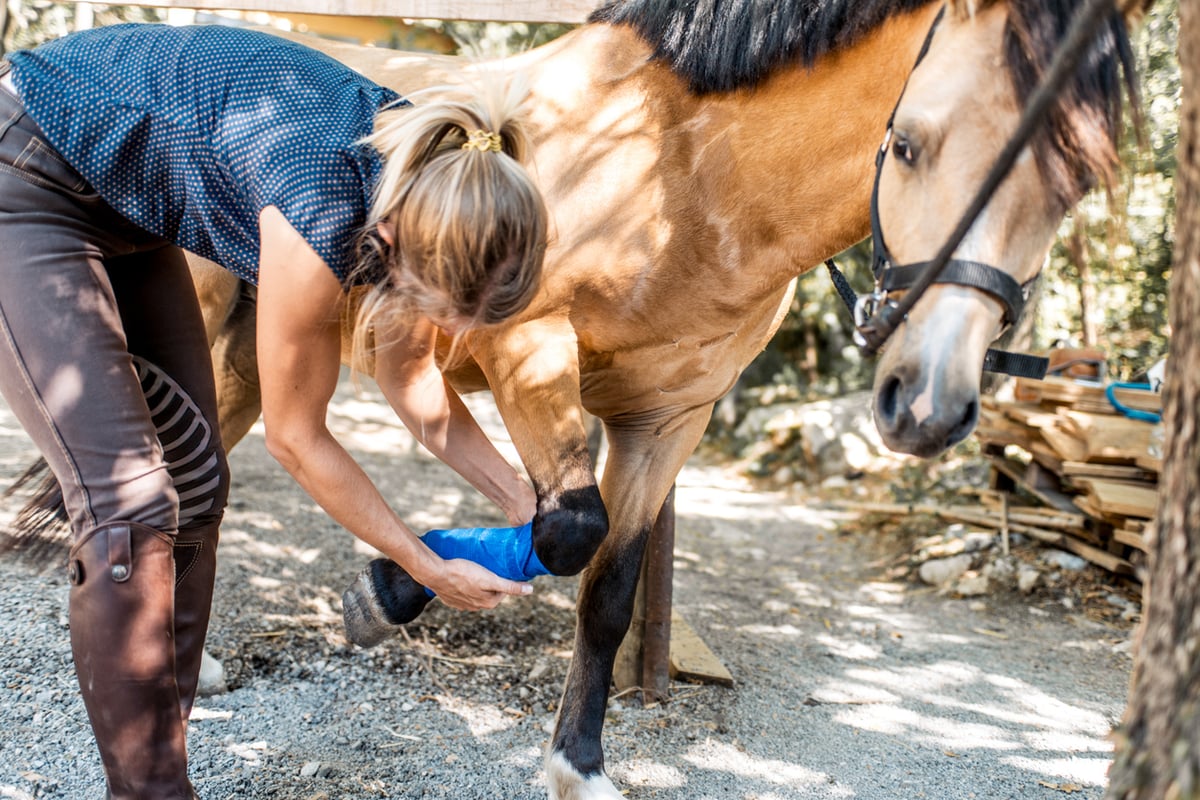
A horse fetlock injury often occurs in performance or sport horses. The two most common ways that the horse injures their fetlock joint are as follows:
- The horse hitting the fetlock with the opposite hoof
- The horse hitting the fetlock on jumps or obstacles
As a result of these actions, the horse can experience bone chips, fractures, bruising, and other trauma to the joint. Fractures of the long pastern bone are common and often present in “chip” fractures along the length of the bone. However, these fractures often occur on the top, upper portion of the long pastern bone and are often caused by overexertion of the fetlock joint due to the horse moving at high speed. A horse with this injury will become lame and show swelling on the fetlock joint.
Comminuted fractures (long fractures) showcase sudden weight-bearing lameness after a race or work. The horse may have significant swelling and be in much pain due to the injury, especially when bending the fetlock joint or touching it.
Prevention of Equine Fetlock Joint Injuries
While equine fetlock joint injuries are unfortunately common, there are ways to help prevent this injury from occurring in your horse.
1. Use Well-Fitting, Lightweight Fetlock Boots
These boots aim to protect your horse’s fetlock joints from knocks during exercise or sport. They usually have a soft inner material, hard outer shell, and adjustable straps.
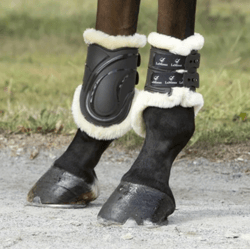
It’s important to note that some types of fetlock boots may not be FEI-legal. In general, the FEI Jumping Guidelines for Use of Saddlery, Equipment, and Dressage outline that the boots must be made of flexible material, fit the horse correctly, and be able to be fastened securely so as to not cause discomfort for the horse.
2. Using Equine Joint Supplements
Horse supplements like TRI-ACTA H.A. are recommended for sport and performance horses because of their high activity level. TRI-ACTA H.A. specifically contains two types of glucosamine for maximum cartilage regeneration and also contains chondroitin sulphate—which works alongside the glucosamines to help prevent the breakdown of cartilage. MSM provides a powerful antioxidant and anti-inflammatory to keep your horse healthy and pain-free. Hyaluronic acid lubricates the joints, helping to minimize friction and enhance the joint’s ability to resist shock.
Because the supplement only contains active ingredients, you’re also getting full value for your money with every container.
TRI-ACTA H.A. for Equine
Our maximum strength formula is perfect for horses that are ageing, experiencing arthritis and stiffness, are in training and competition, or under a heavy workload.
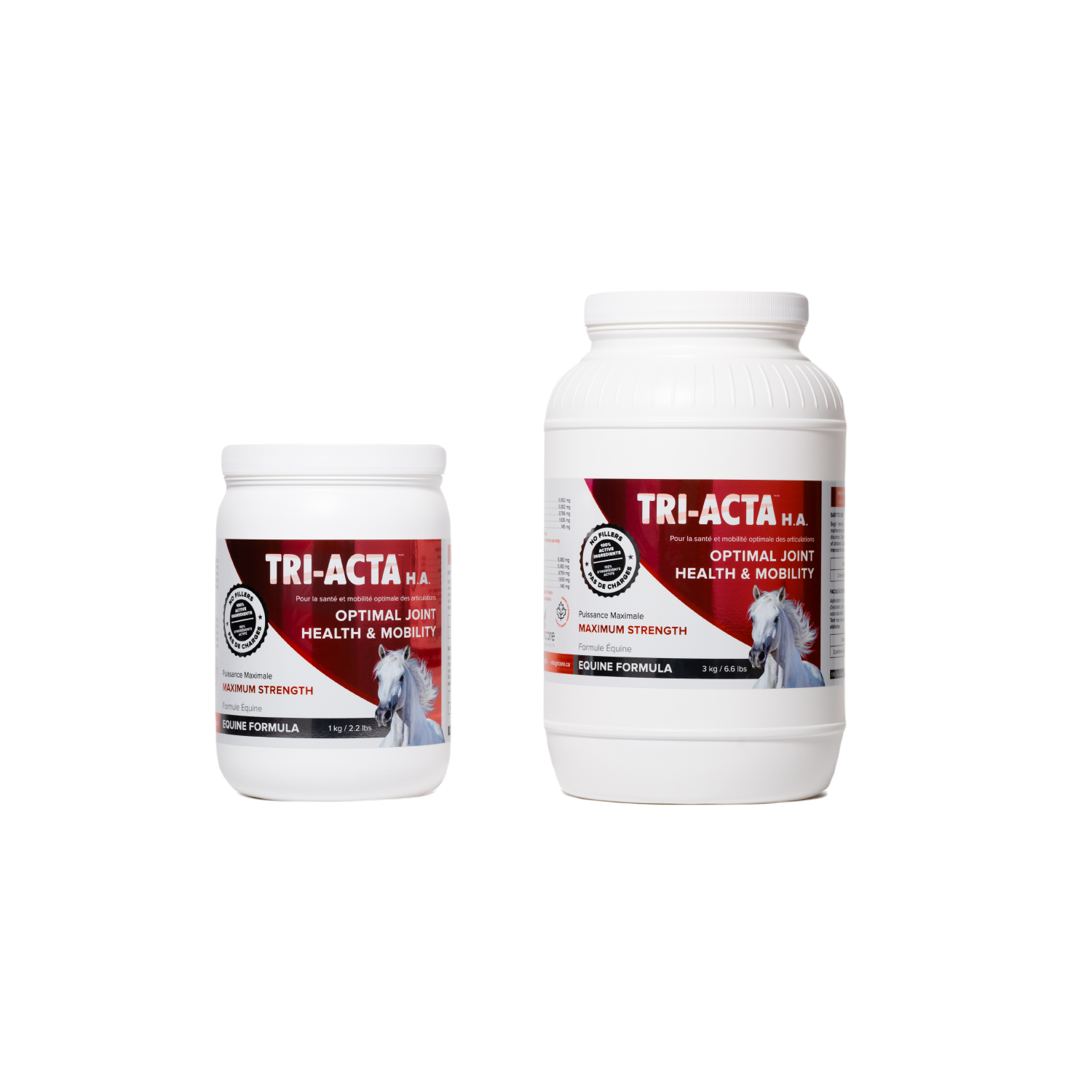
3. Stretching
Before competition or exercise, it’s important to stretch your horse correctly so that its muscles and joints are limber and prepared for activity. Proper equine stretching of the front and back legs should be done to help prevent any injury to the fetlock joints due to overexertion. For front leg stretches, avoid raising the leg too high. Doing so can overstress the shoulder and elbow joints. For hind leg stretches, attempt to place the hind leg behind the front leg, but don’t force this stretch because you may strain the hock or stifle. Remember to keep the foot low as well.
Treatments for Horse Fetlock Joint Injuries
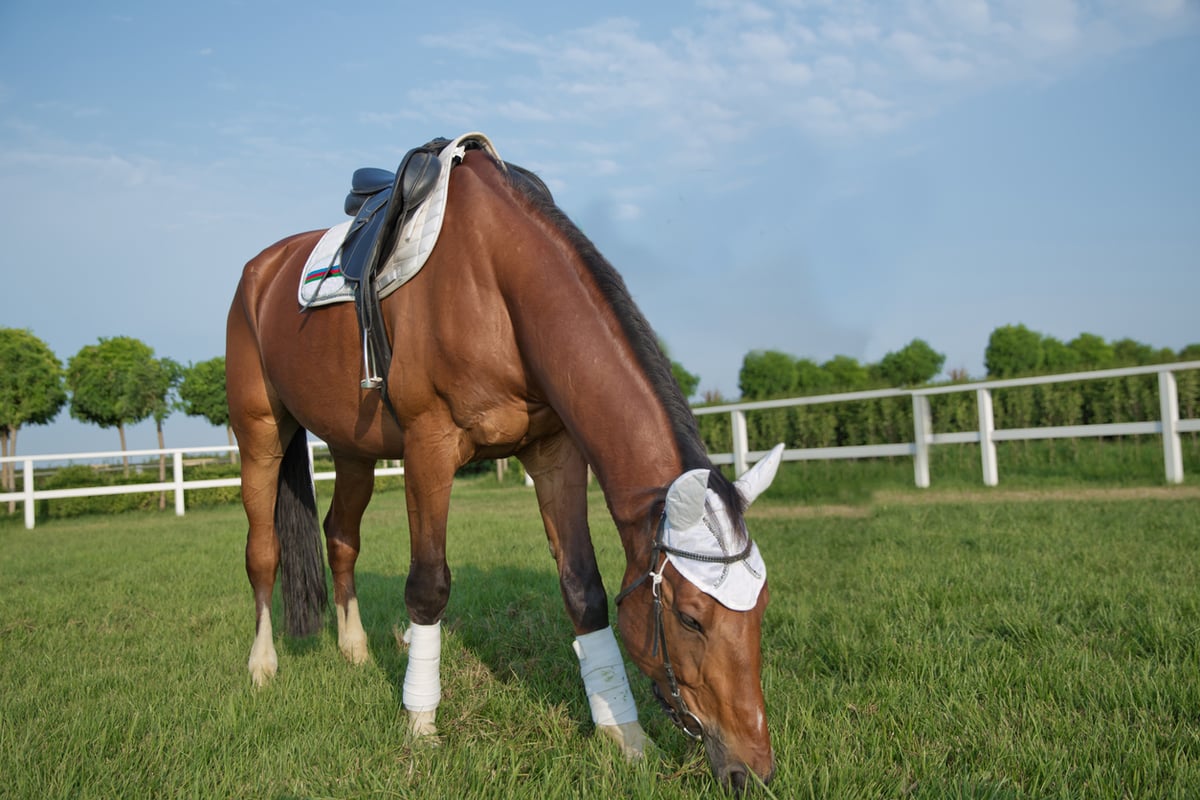
Common methods used to treat horses with an equine fetlock joint injury are outlined in the following table:
| Horse Fetlock Joint Injury Treatment |
Description |
| Rest and recuperation |
Allowing your horse to rest goes a long way in helping them to recover from a fetlock injury. Confine them to a stable or small paddock for several hours a day to help them recuperate. |
| Joint supplements |
Using an effective joint supplement like TRI-ACTA H.A., either alone or alongside another treatment, significantly aids in helping your horse recover from a fetlock injury. |
| Joint injections (NSAIDs) |
In some cases, low doses of corticosteroids alongside hyaluronic acid may be used to help reduce inflammation and lameness. |
| Surgery |
Surgery may be required to remove the loose bone chips for horses that experience bone chipping of the fetlock and other fractures. This surgery is usually done via arthroscopy and has a short recovery period. |
| Surgical Screws |
In some cases, surgical screws may be used to compress a fracture and restore joint strength. |
Alternative therapies for treating horse injuries are also increasing in popularity. This includes the following:
- Acupuncture—Just like in humans, this is a drug-free approach to pain relief that involves inserting special ultra-fine needles into key areas of the horse’s body, called acupoints, to stimulate the central nervous system and encourage the body’s natural healing capabilities)
- Chiropractic—Involves making specific movements and adjustments to the horse’s body to relieve pain and discomfort caused by joint, horse muscle, and ligament injuries. Might be effective in temporarily relieving pain but won’t reverse degenerative issues that are already present in the horse.
- Low-level laser therapy—Where laser devices emit infra-red levels of light to the affected area, encouraging natural healing by the horse’s body
- Therapeutic ultrasound—Uses sound waves to penetrate the tissue, providing deep healing that increases blood flow to the target area
Summary
The first step in horse fetlock joint injury treatment is prevention. If you take preventative measures, like using equine fetlock joint boots, stretching your horse properly, and giving your horse joint supplements, you can help give your horse’s body the tools needed to keep the fetlock joint strong and healthy. Joint supplements should include key ingredients like glucosamine for horses, chondroitin, MSM, and hyaluronic acid.
If a fetlock joint injury does occur, however, you can provide a wide variety of treatments to your horse. These treatments include rest, surgery, and NSAIDs. You should also provide joint supplements to your horse during recovery to help them recover faster.
It's an easy choice regarding which joint supplement you should give your horse. TRI-ACTA H.A. is formulated to help maintain the health of sport and performance horses and horses that are aging or experiencing joint issues like osteoarthritis, lameness, and more.
TRI-ACTA H.A. for Equine
Our maximum strength formula is perfect for horses that are ageing, experiencing arthritis and stiffness, are in training and competition, or under a heavy workload.

Check out where to buy TRI-ACTA H.A. today.
Newsletter Signup
Subscribe to our newsletter to receive the latest news and exclusive offers.
.jpg?height=2000&name=Cliick_Integricare-DISPLAY-REVISEDV2%20(1).jpg)
Proactive & Therapeutic Joint Supplements
When given daily, Integricare joint supplements recover bone and joint injuries faster and help prevent mobility injuries from happening in the first place.

